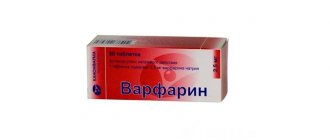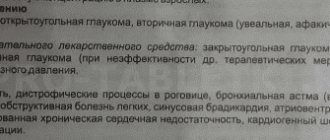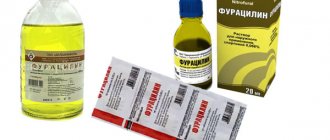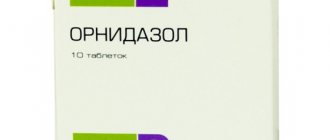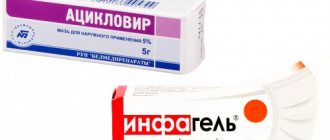Instructions for use
Heparin is a high molecular weight compound with a mass of 16,000 Daltons, which is produced by mast cells (tissue basophils) in the blood along with histamine and other biologically active substances.
The mechanism of action of heparin is associated with blocking blood coagulation factors and activation of the anticoagulant system (due to interaction with antithrombin III, the function of which increases 700 times). Thus, the time of plasma hemostasis is extended and the formation of blood clots is reduced.
The properties of the drug depend on the fraction:
- low – prevent the formation of blood clots;
- medium - cause hypocoagulation, prolong prothrombin time;
- high – have antiplatelet properties, reduce the “clumping” of platelets.
In addition, Heparin has other pharmacological actions, which makes it widely used in practice:
- anti-inflammatory and immunosuppressive – suppressing antibody-antigen reactions and activation of the complement system;
- antiplatelet – “thinning” of the blood;
- hypoglycemic - by increasing insulin activity, reducing blood sugar levels;
- antiallergic: heparin acts as an antagonist of histamine, the main mediator of allergies;
- anti-atherosclerotic by reducing the concentration of cholesterol and beta-lipoproteins in the blood plasma;
- enhances the secretion of thyroid hormones;
- diuretic (weak diuretic).
The wide spectrum of action of the drug requires careful use due to severe complications.
The medication does not penetrate the fetoplacental barrier, which makes Heparin the drug of choice for the treatment of thrombosis in pregnant women.
Indications for use
Instructions for use of Heparin involve the use of the drug in the following cases:
| Injection form (subcutaneous or intravenous) | Local (ointment, spray or gel) |
|
|
In addition, the drug is used to flush catheters that are installed for long-term venous access.
In medical practice, unfractionated (whole) heparin is most often used. However, there are modern drugs - low-molecular analogues, which are often used to prevent thrombosis in patients with acute or chronic renal failure on hemodialysis (Enoxiparine, Fraxiparine).
Composition and dosage forms
The drug is available for parenteral (vial with injection solution) and external use.
The composition of the product depending on the form is presented in the table.
| Injection form (subcutaneous or intravenous) | Active substance | Auxiliary components |
| Solution for injection (10 bottles of 5 ml per package) | Heparin Sodium at a concentration of 5000 units/ml |
|
| Gel for external use (tube of 30 or 50 grams) | Heparin sodium 1000 units/g |
|
| Heparin ointment (tubes of 50 and 100 grams) |
|
|
There is no oral form for internal use (tablets, capsules, syrup) with heparin, since the active molecule is destroyed by enzymes in the digestive tract before it can enter the bloodstream.
Dosage and method of use
The selection of an effective dose of the drug, route of administration and course duration depends on the pathology, age and weight of the person. Most often in hospital treatment, subcutaneous injections of Heparin are prescribed, which are used in the following dosage:
- for myocardial infarction – 7500 units 3 times a day or 10000-12500 units 2 times a day;
- preoperative prevention of thromboembolic complications: 2500-4000 units 2 hours before surgery, and every 6-8 hours after.
The subcutaneous injection technique (most often in the abdominal area) involves the use of a special syringe (“insulin”) for dosage accuracy with the needle inserted at an angle of 30°.
Intravenous fluids are used to provide emergency medical care for:
- venous and arterial thromboembolism (pulmonary, mesenteric, cerebral, renal vessels) according to the algorithm up to 10,000 units in a jet, then through a dispenser-perfuser 25-40 thousand units/day. For children, the required dose is calculated by weight: the first dose is 50 units/kg, then 20 units/kg/hour.
- DIC syndrome (hypercoagulation phase) - administer 2500-4000 IU/day.
Parenteral manipulations are performed by a doctor or nursing staff.
Local use of the drug (gel, ointment) is prescribed to patients with pathologies of superficial vessels (varicose veins, thrombophlebitis, thrombosis of hemorrhoidal veins). Features of application:
- The product is applied in a thin layer to the skin 2-3 times a day;
- for hemorrhoids - administered using a gauze swab or under a bandage (if the nodes are located externally);
- the duration of local therapy is determined by the attending physician, usually up to 3 weeks;
- Do not apply to damaged skin (wound), mucous membranes or in areas of purulent inflammation.
To prevent overdose and the effectiveness of the selected amount, coagulogram monitoring is used, a specific indicator is APTT (activated partial thromboplastin time).
Contraindications
The pronounced anticoagulant effect of the drug and the effect on other organs and systems forms a list of conditions in which heparin is contraindicated:
hemorrhagic diathesis: thrombocytopathy, thrombocytopenia, vasculitis (vascular pathologies), hemophilia;- hypersensitivity (allergic reaction) to the components of the drug;
- peptic ulcer of the stomach and duodenum;
- malignant neoplasms;
- hemorrhagic stroke or central nervous system injury;
- endocrine pathologies of the thyroid gland (with caution in patients with diabetes mellitus);
- malignant arterial hypertension;
- infective endocarditis (due to an increased risk of blood clot detachment from the valve);
- prostate adenoma (contraindicated for rectal use).
It is forbidden to inject heparin in the early postoperative period after neurosurgical, abdominal and ophthalmological interventions, in the case of using epidural anesthesia.
The product is not used if the rules for preparing or storing the solution are violated.
Side effects
Heparin belongs to the group of mucopolysaccharides of animal origin with a wide range of pharmacological effects, so there are a number of side effects of the drug:
- allergic reactions: redness or rash in the area where the drug is applied. With parenteral administration - lacrimation, fever, bronchospasm;
- dizziness;
- loss of appetite, nausea;
- increased bleeding - petechiae on the skin;
- gastrointestinal, renal, nosebleeds;
- transient hair loss (alopecia), osteoporosis, arterial hypotension (due to decreased aldosterone synthesis in the adrenal glands) - with long-term use;
- increased activity of liver enzymes (rare).
The risk of bleeding increases with simultaneous use of Heparin with indirect anticoagulants (Warfarin, Syncumar), non-steroidal anti-inflammatory drugs (Aspirin).
The drug is not recommended for use with alcohol or high doses of antibiotics due to a significant increase in the activity of liver transaminases.
Overdose symptoms and their treatment
The use of Heparin without following the prescription, especially when administered intravenously, is often accompanied by signs of overdose in the form of bleeding from the gastrointestinal tract, urinary system, genitals, and sometimes cutaneous hemorrhagic rashes.
In addition, complications are possible when used on the skin over a large area (for example, in children - from the feet to the knees).
Heparinized plasma in case of intoxication is not prone to self-destruction of the process, therefore specific antidote therapy is required - a 1% solution of protamine sulfate.
Dose calculation: 1 mg of antidote binds 100 units of heparin. 50% of the drug must be administered in the first 90 minutes after the onset of overdose symptoms, the remaining amount within 3 hours.
Additionally, pathogenetic and replacement therapy is used, and, if necessary, plasma transfusion.
Compound
The injection solution contains sodium heparin at a concentration of 5 thousand units/ml.
The auxiliary components of the drug include sodium chloride, benzyl alcohol, and water. 1 gram of gel contains 1 thousand units of sodium heparin , as well as auxiliary components: 96% ethanol, carbomer , dimethyl sulfoxide, propylene glycol, dietanolamine, methyl and propylparaben (additives E 218, E 216), lavender oil and purified water.
Analogues and substitutes of the drug
The modern pharmaceutical market offers a number of drugs - analogues of Heparin for local and parenteral use:
- gels: Trombless, Lyoton 1000, Trombogel 1000;
- Viatromb gel spray;
- ointment: Thrombophobe;
- solution for injection: Heparin Sodium, Heparin Lechiva.
In cardiological practice, heparin substitutes are often used - indirect anticoagulants, which help combat increased thrombus formation with long-term use. For the convenience of the patient, the products are available in the form of tablets - Sinkumar, Warfarin, Phenilin, Neodicoumarin.
Monitoring the effectiveness of drugs for this cereal is the INR (international normalized ratio) indicator, which must be strictly carried out according to a special scheme
pharmachologic effect
Pharmacological group: anticoagulants .
Group of the drug Heparin, produced in the form of a gel: drugs for the treatment of cardiovascular diseases.
Group of the drug Heparin, produced in injection form: agents affecting blood and hematopoiesis.
Heparin sodium contained in the drug has an antithrombotic effect , slows down the aggregation and adhesion of leukocytes , platelets and erythrocytes ; reduces wall spasm and the degree of vascular permeability; helps improve collateral circulation.
conclusions
Heparin is a strong anticoagulant drug that is most often used in hospital settings due to its wide range of effects and high risk of overdose. The correct concentration of the drug is used for increased formation of blood clots, myocardial infarction, stroke and other thromboembolic pathologies. The selection of the dose, method and frequency of administration is regulated by the doctor depending on the sensitivity of the patient and the presence of risk factors (old age, alcoholism, use of other drugs).
Contraindications
Heparin containing ointments (Heparin, Heparin-Acrigel 1000, etc.) are contraindicated in cases of hypersensitivity to the components they contain, as well as in diseases accompanied by ulcerative-necrotic processes, and injuries that are accompanied by violations of the integrity of the skin.
Heparin gel (ointment) should be used with caution in case of thrombocytopenia and increased tendency to bleeding.
Contraindications to the use of the injection form of the drug:
- hypersensitivity;
- diseases accompanied by increased bleeding ( vasculitis, hemophilia , etc.);
- bleeding;
- aortic dissection , intracranial aneurysm;
- antiphospholipid syndrome;
- traumatic brain injury;
- hemorrhagic stroke;
- uncontrolled hypertension;
- liver cirrhosis , accompanied by pathological changes in the veins of the esophagus;
- threatened miscarriage;
- menstrual period;
- pregnancy;
- childbirth (including recent);
- lactation period;
- erosive and ulcerative lesions of the stomach and intestinal tract;
- recent surgical interventions on the prostate gland, brain, eyes, bile ducts and liver, as well as the condition after lumbar puncture .
Heparin injections should be prescribed with caution to patients with polyvalent allergies (including bronchial asthma ), diabetes mellitus , arterial hypertension , active tuberculosis , endo- and pericarditis , chronic renal failure, liver failure ; patients undergoing dental procedures or radiation therapy; persons over 60 years of age (especially women); women using an IUD.
Reviews
Heparin is an effective and well-studied antithrombotic agent , the mechanism of action of which is to suppress the activity of thrombin , which catalyzes the biotransformation of fibrinogen into fibrin and a number of other reactions in the hemostatic system.
Most often, the external use of gel and ointment forms of the drug is discussed on the Internet. Reviews of heparin-containing ointments and gels (in particular, reviews of Heparin Acrigel 1000 ) are overwhelmingly positive: such drugs really help with bruises, thrombophlebitis and hemorrhoids , and also remove localized infiltrates well.
Interaction
Drugs that block tubular secretion, indirect anticoagulants that reduce the formation of vitamin K by intestinal microflora, antibiotics, NSAIDs, dipyridamole , ASA and other drugs that reduce platelet aggregation enhance the effect of heparin.
The weakening of the effect is facilitated by: cardiac glycosides , ergot alkaloids , phenothiazines , antihistamines, nicotine , ethacrynic and nicotinic acids , nitroglycerin (iv administration), ACTH, tetracyclines , alkaline amino acids and polypeptides, thyroxine , protamine .
Do not mix the solution in the same syringe with other medications.
When applied topically, the anticoagulant effect of the drug is enhanced when the gel is used in combination with antiplatelet agents, NSAIDs, and anticoagulants. Tetracycline , thyroxines , nicotine and antihistamines reduce the effect of heparin.
Side effects
When used externally, Heparin sodium can cause skin hyperemia and hypersensitivity reactions.
When administering the solution, the following are possible:
- Hypersensitivity reactions ( drug fever , skin hyperemia, rhinitis , feeling of heat in the soles, urticaria , skin itching, collapse, bronchospasm , anaphylactic shock ).
- Headaches, dizziness, diarrhea, loss of appetite, nausea, vomiting;
- Thrombocytopenia (in approximately 6% of patients), sometimes (rarely) with death. Heparin-induced thrombocytopenia (HIT) is accompanied by: arterial thrombosis , skin necrosis and gangrene , stroke , myocardial infarction . In case of severe HIT (when the platelet is reduced to half the original number or below 100 thousand/μl), heparin should be stopped immediately.
- Local reactions ( hematoma , hyperemia , pain, ulceration, irritation at the injection site, bleeding).
- Bleeding. Typical ones are considered to be from the urinary tract and gastrointestinal tract, in areas that are subject to pressure, at the site of drug administration, from surgical wounds. Hemorrhages are also possible in various internal organs: in the retroperitoneal space, corpus luteum, adrenal glands, etc.
With long-term use of Heparin, intermittent alopecia , osteoporosis , hypoaldosteronism , soft tissues become calcified, spontaneous bone fractures occur, and the activity of liver transaminases increases.
Heparin price
The average price of Heparin injections in Ukrainian pharmacies is from 180 to 226 UAH (5 ml ampoules, No. 5). You can buy Heparin ointment for an average of 35 UAH. The price of Heparin Acrigel 1000 in Ukraine is about 250 UAH.
In Russian pharmacies, sodium heparin in ampoules can be purchased for 360-550 rubles. The price of Heparin gel is 260-300 rubles.
- Online pharmacies in RussiaRussia
- Online pharmacies in UkraineUkraine
- Online pharmacies in KazakhstanKazakhstan
ZdravCity
- Heparin ointment for external use tube 25 gPAO Biosintez
55 rub. order - Heparin ointment 25g NizhpharmAO "Nizhpharm"
66 RUR order
- Heparin-Akrikhin 1000 gel for external use. approx. 1000 IU/g tube 50g JSC AKRIKHIN
450 rub. order
- Heparin ointment 25g n1Altaivitaminy JSC
114 RUR order
- Heparin-Akrikhin 1000 gel 1 thousand. IU/1g 30gAO Akrikhin
RUB 332 order
Pharmacy Dialogue
- Heparin-Akrikhin gel (gel 1000EM/g 50g) Akrikhin JSC
RUR 451 order
- Heparin ointment (tube 25g) Nizhpharm JSC
72 RUR order
- Heparin-Acrigel (gel 1000EM/g 30g) Akrikhin OJSC
RUB 298 order
- Heparin (vial IV and SC injection 5tIU/ml 5ml No. 5) Belmedpreparaty
1812 RUR order
- Heparin ointment (tube 25g)Green oak forest
50 rub. order
show more
Pharmacy24
- Heparin-Darnitsa 600 units 30 g gel PrAT" Pharmaceutical company "Darnitsa", Ukraine
62 UAH. order - Heparin ointment 25 g TOV DKP Pharm.Fabrika, Ukraine
46 UAH order
- Heparin-Indar 5000 MO/ml 5 ml (25000 MO) No. 1 solution PrAT “On the production of insulin” Indar”, m. Kiev, Ukraine
34 UAH order
- Heparin-Novopharm 5000 MO/ml 5 ml No. 5 solution Novofarm-Biosintez TOV, Novograd-Volinsky, Ukraine
256 UAH order
PaniPharmacy
- Heparin ointment Heparin ointment 25g tube Ukraine, Zhytomyr FF LLC
60 UAH.order
- Heparin gel Heparin gel 30g Ukraine, Darnitsa ChAO
68 UAH order
- Heparin bottle Heparin solution d/in. 5000U/ml 5ml vial. №5 Ukraine, Pharmstandard-Biolek
166 UAH order
- Heparin solution d/in. 25000U/ml 5ml No.1 Ukraine, INDAR
39 UAH order
- Heparin bottle Heparin-Novopharm solution d/in 5000 MO bottle. 5ml. No.5 Ukraine, Novofarm-Biosintez LLC
268 UAH order
show more
Overdose
Symptoms of overdose with parenteral use are bleeding of varying severity.
Treatment: for minor bleeding caused by an overdose of the drug, it is enough to stop using it. If bleeding is extensive, protamine sulfate (1 mg per 100 IU of heparin) is used to neutralize excess heparin.
Please note that heparin is eliminated quickly. Thus, if protamine sulfate is administered 30 minutes after the previous dose of heparin, it should be administered at half the dose; The highest dose of protamine sulfate is 50 mg.
It is not excreted by hemodialysis.
Cases of overdose with external use of the drug have not been described. Due to the low systemic absorption of the drug, an overdose is considered unlikely. With prolonged use on large surfaces, hemorrhagic complications .
Treatment: discontinuation of the drug, if necessary, use of a one percent solution of protamine sulfate (heparin antagonist).
